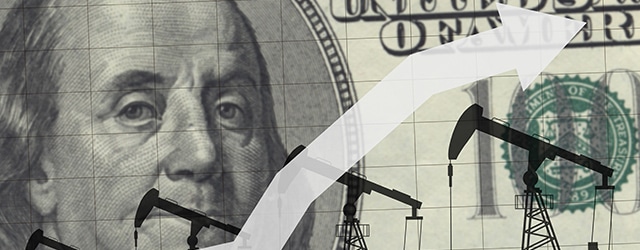A few years ago Brent crude hit a low of $27 per barrel. Recently it topped $80. What are the macro consequences of higher prices?

Oil-producing countries were shocked when the commodity plummeted from more than $100 per barrel in 2014 to $27 a barrel in January 2016. Saudi Arabia and Russia called a meeting of oil-producing nations in Vienna—even though Russia is not a member of the Organization of Petroleum Exporting Countries—and agreed to stabilize prices.
Robert McNally, president of the Rapidan Group consulting firm in Washington, says Saudi Arabia’s goal was straightforward: “to get off the global oil roller coaster … cut production and try to act as the swing producer” (a supplier with the capacity and power to determine market prices), in order to bring some stability at a viable price.
The Vienna Group (as McNally dubs it) may have been too effective. As Brent crude approached $80 a barrel in May, a report by UBS warned that oil was outside a “sweet spot” of $50 to $70 where it contributes to global growth.
What are the implications for the global economy, emerging markets, the oil industry, renewables or electric vehicles (EVs)? Might oil decide the fate of all?
1. Is the global economy at risk?
There’s little consensus about the overall economic impact. UBS analysts say that if oil hits $100, global growth would slow and inflation would rise. In the US, UBS points out, “oil spikes preceded five of the last six recessions.” The country’s current status as the world’s largest producer (due to the shale bonanza) gives it little protection: Its car culture, small oil sector relative to the economy, and pipeline-capacity constraints mean the net impact of higher prices would still be negative.
Elsewhere, conditions for an oil shock are even more worrying, according to Rob Subbaraman, head of emerging-markets economics at Nomura in Singapore. “Economies and markets are fragile because superloose monetary policy is being normalized, emerging markets [are in] turmoil, global growth is no longer synchronized and trade protectionism is rearing its ugly head,” he says. “The European Central Bank [sees] signs that protectionism is prompting firms to postpone investment and hiring.”
Subbaraman believes a sustained oil shock—lasting for several months—would add to pressures on growth at a dangerous time for the world economy. At the least, rising oil prices make it harder for central banks to gauge inflation, raising the chances of an error that could unleash inflation or undercut growth.
Still, there are mitigating factors. While the current spike is the 11th-biggest in the last 70 years, it is smaller than those that caused past recessions. Moreover, as Janet Henry, global chief economist at HSBC in London, explains in a blog post, while “every recession [in the past 50 years] has been preceded by an oil-price rise … higher oil prices have not always been followed by a recession,” emphasizing that “there is no direct link between the oil price and GDP growth or medium-term inflation.”
2. How will emerging markets react?
Oil’s cost matters more in emerging markets than developed markets, explains Rabah Arezki, chief economist for the Middle East and North Africa at the World Bank in Washington, DC. “Developed-market economies tend to be more focused on services and are therefore less exposed to the impact of high oil prices,” he notes. Emerging-market countries are both more energy intensive and less energy efficient.
However, the interplay of factors is complex. “[The impact of costly oil] depends on what drives the increase,” says Nomura’s Subbaraman. “If it’s global growth, that’s not too bad for emerging markets; because while oil importers, such as India, have to pay more for oil, there is still strong demand for their exports.”
Currently, however, prices are largely being pushed up by supply-side factors—geopolitical tensions and disruptions, and thus the effects are worse for oil importers—and not as beneficial for exporters—as a demand-led rise. “There is cause for concern,” says Subbaraman. “We are already starting to see a widening of trade deficits, for example in India (where inflation has also picked up), the Philippines and Turkey, and a truckers’ strike [over fuel prices] in Brazil.”
As the strike shows, costly oil is testing governments in emerging markets. “There are, of course, tensions,” says Arezki. “Consumers are feeling the pinch.” When oil was cheap, many countries made efforts to reduce subsidies. “The hope is that governments will resist the pressure to reintroduce subsidies,” Arezki continues, “and instead, if necessary, introduce mitigatory measures, such as in Egypt.”
Arezki argues that countries should favor “a targeted social security system, independent of oil prices,” over subsidies, because it is fairer and more economically beneficial. Egypt has introduced targeted transfers aimed at the poorest, salary bonuses for public-sector employees and pension increases aimed at the middle class. So far, China and India have also resisted pressure to reverse subsidy reductions, notes Arezki.
3. Will geopolitics change?
For some producers, pricey oil has been a lifeline. Rapidan’s McNally cites Venezuela: “The country is still imploding, but the process is now much slower. Without oil at current prices, a tipping point would undoubtedly have been reached.”
Higher prices have politically emboldened exporters such as Russia and Saudi Arabia. Yet here, too, complexity rules. Oil suffered multiple prolonged slumps in recent decades while Saudi Arabian society remained unchanged. Then, during the latest low-price period, from 2015 through 2017, national leaders decided to revamp the economy, says Samantha Gross, fellow in the Cross-Brookings Initiative on Energy and Climate in Washington, DC. “That was in large part because of the realization that they can no longer depend on oil,” she says. “Tangentially, the liberalization taking place—such as allowing women to drive—is part of the same trend.”
There are simply too many factors—political, economic and social, and both domestic and international—to make concrete predictions about impacts due specifically to an oil-price rally.
4. Should the industry be partying?
More than any other, the oil sector veers from wild partying, with loose purse strings, to lethargy once the hangover kicks in. Now, the industry is still benefiting from changes made in tough times, according to Scott Nyquist, senior partner in oil and gas, at McKinsey in Houston. “The industry got itself into a $50-a-barrel mind-set. It went through a tough restructuring that positioned it to generate returns at that price,” he says. “Some CEOs say they can now make as much money at $50 as they used to at $100.”
Nevertheless, when prices collapsed, every capital project that could be stopped was stopped, recalls Nyquist. As prices started rising in 2017, capital expenditures (capex) increased; but the pace of growth has not accelerated with the recent price bump. “That’s because many believe that today’s prices are being driven by geopolitical concerns, such as Venezuela and Iran, rather than fundamentals,” he says. “In addition, the independent sector in the US has built a reputation for consuming cash and chasing growth.” Nyquist predicts that capex will grow at around 5% a year in the medium term.
Saudi Arabia and Russia’s Vienna Group should be able to sustain cooperation while increasing supply in the short term, according to McNally. “The hard work will come when they have to prevent a price boom,” he says. “Saudi might have the foresight and capabilities to do this, but Russia is unlikely to resist going to maximum capacity: When a boom comes, greed replaces fear and memories fade.”
5. Is this a tipping point for electric vehicles?
Higher oil prices have made renewables more competitive, notes Nyquist. “During periods of price rises in the past, there has been a shift to more fuel-efficient vehicles. That is likely to occur again,” says Cross-Brookings’ Gross. “However, there remains a price premium for electric vehicles; overcoming this up-front cost, range anxiety and concern about charging infrastructure will be necessary for EVs to take off.”
Nyquist says EVs are 10-15 years behind solar and wind in terms of economic viability and still rely on big subsidies. “Some West Coast pundits predict EVs will constitute 90% of the auto market by 2030. We don’t see that,” he adds. The International Energy Agency expects EVs to displace 2.5 million barrels per day (bpd) by 2030. In 2017 the US used nearly 20 million bpd, according to the US Energy Information Administration.
Hence, the industry is skeptical that oil will be replaced in transportation any time soon. “They play along largely to ensure they stay in good graces with governments and society; they don’t want to be the skunk at the party,” McNally explains. There have been other alternative fuels in transport, including electric and alcohol, but oil delivers affordable, scalable transport. “When that happens with electric vehicles, they will be successful,” says McNally.
The risk for the oil industry—and the opportunity for EVs—is that oil would come to be seen as unreliable. “If that happens, the investors and users of oil will seek an alternative,” says McNally. “Prolonged boom-and-bust price swings are much more likely to succeed at ushering in an energy transition than government mandates or subsidies.”
Of course, while oil-price volatility could herald an EV dawn, it would also have serious macroeconomic and geopolitical consequences. Whatever happens, oil will continue to drive the world for the foreseeable future.



